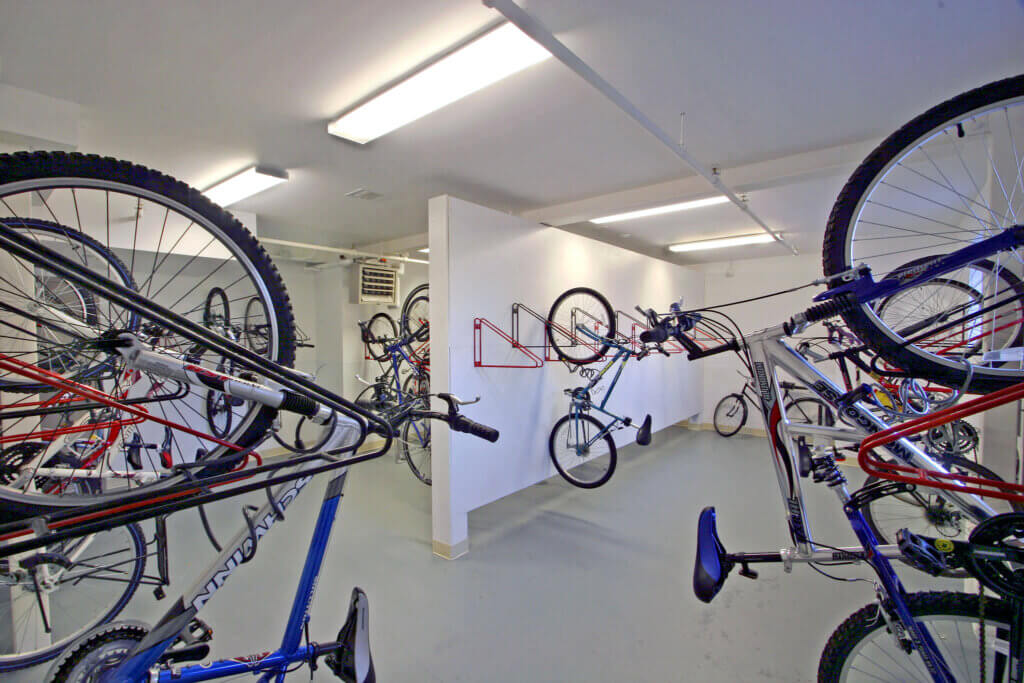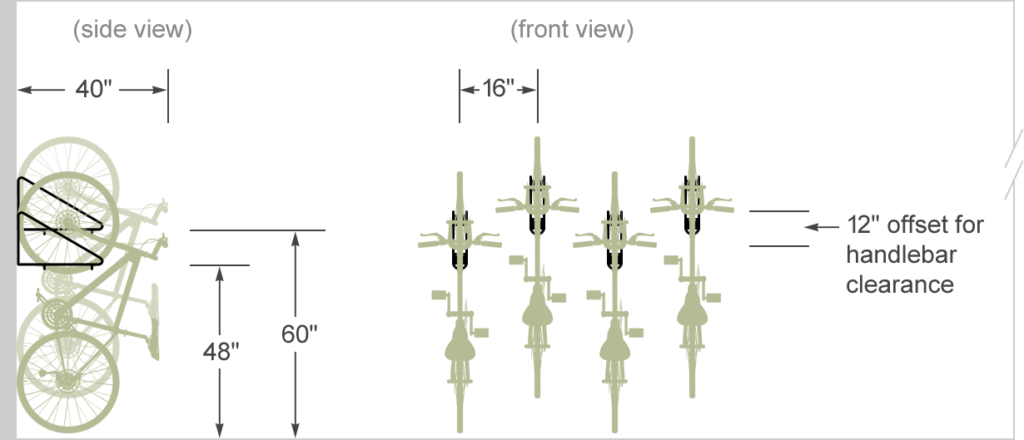Indoor bike rooms and outdoor bike lockers are two alternatives for secure long-term bike parking. Utilizing existing space inside a building has many useful applications, and some significant considerations when creating a bike parking plan. Bike lockers are invaluable when indoor space is nonexistent, or a slightly higher level of security is needed. Designed correctly, either can be a great solution depending on needs. When creating a secure bicycle storage plan there are differences in the amount and nature of costs associated with each storage solution. Below are some cost considerations to take into account when deciding which class 1 bike parking option may be best for your end users’ needs.

Indoor Bike Rooms
The construction, installation, and operating costs of an indoor bike room can vary significantly depending on location, size, materials, security features, and amenities. Here’s a breakdown of the typical costs associated with each phase:

STAGE 1 – Construction Costs
- Building or Renovation Costs: This includes the cost of constructing or renovating a dedicated indoor space to house the bike room. Costs can vary widely based on factors such as location, size of the space, existing infrastructure, and any necessary modifications. Costs to consider include design fees, rough framing, electrical, mechanical, plumbing, carpentry, wall ceiling, and flooring surface finishes. Existing spaces may require costly retrofits to remove obstructions or reroute HVAC to provide sufficient clearance for racks and lockers.
- Safety and Security Features: Security equipment, such as access control systems, surveillance cameras, alarms, and secure locking mechanisms for the room and individual storage spaces, can add significant costs to the project. The complexity and sophistication of these systems will affect the overall cost. Fire protection and emergency egress may also be required. Keep in mind, every inch of additional security outside of something to lock a bike to in a bike room will be seen as a luxury and an incentive for end users to utilize the space.
- Bike Racks and Storage Solutions: The cost of purchasing and installing bike racks or storage solutions can vary based on the end goal of the product. The type, design, capacity, and functions of the racks largely drive price points. Rudimentary racks can be relatively inexpensively designed, while high-density and specialized solutions can require larger investments. The ideal bike room is configured with a range of different bike racks that service many different user needs, as well as locker options that offer an extra layer of protection for users who require additional security.
- Lighting: Adequate lighting in the bike room is crucial for safety and security. Costs for lighting installation will depend on the type of fixtures used, the number of fixtures required, and the complexity of the wiring. Popular inclusions such as LED lighting and motion/timer-based lighting control systems will add to the total lighting cost.
- Networking & Electrical: Bike rooms should include appropriate network cabling for WiFi, door locks, access control, security cameras, TVs, monitors, and any other network devices. Bike rooms should also consider electrical outlet needs cyclists have such as for e-bikes, phones, watches, ear pods, and tire pumps.
- Ventilation and Climate Control: Depending on the location of the bike room, you may need to invest in ventilation or climate control systems to ensure proper airflow and prevent moisture buildup. Costs can vary depending on the size of the space and the specific requirements.
- Top Tier Amenities: Amenities that bring your bike room to the next level for your end users such as shower facilities, water fountains and bottle filling stations, and bike washes require additional plumbing infrastructure to budget and dedicate space for. Additional space planning is also required for personal lockers, benches, bike repair stations, air pumps, and mirrors.
STAGE 2 – Installation Costs
- Security Measures: Installation of security cameras, access control systems, and alarms will incur installation costs in addition to the equipment costs.
- Bike Racks and Storage Solutions: The installation of bike racks and lockers may require professional assembly and installation services.
STAGE 3 – Operating Costs
- Maintenance: Regular maintenance is essential to keep the bike room in good condition. This includes cleaning, routine inspections, and repair or replacement of damaged infrastructure. Maintenance costs will depend on the quality of materials used and the level of usage. Cleaning and maintenance costs can be minimized by selecting equipment, such as wall rack tire guard plates, that prevent marring and other wall damage.
- Utilities and Security Monitoring: If the bike room requires lighting (especially if it’s in a basement or enclosed space), ongoing utility expenses will be incurred. If you have security cameras or surveillance systems, there will likely be costs associated with monitoring and maintaining these systems.
- Supplies: Costs for supplies like cleaning materials, maintenance materials such as replacement keys or lock cylinders at the end of rental periods, and other consumables should be budgeted for.
- Repairs and Upgrades: Over time, you may need to budget for repairs or upgrades to the bike room especially if user needs grow, such as additional security systems, lighting, or amenities to ensure continued functionality and user satisfaction.
- Staffing: If the bike room requires regular monitoring or oversight, staffing costs may need to be considered. Many cyclists in heavily populated areas will only use a bike room with a concierge present, as having them staffed reduces the chances of theft significantly.
- Miscellaneous Costs: Other miscellaneous costs may include signage, periodic inspections, and pest control, among others.
It’s important to conduct a thorough cost analysis when planning the construction, installation, and operation of an indoor bike room. Costs can vary widely depending on the specific needs and requirements of your project. Consulting with professionals experienced in bike room design and management can help you obtain accurate cost estimates tailored to your situation.
When you’re considering designing your indoor bike room or retrofitting an existing bike room for today’s cycling community, get in touch with one of our bike room design specialists. We’re here to help determine the best solution for your specific bike room needs.
Outdoor Bike Lockers
The construction, installation, and operating costs of outdoor bike lockers can vary based on several factors, including location, equipment choices, security features, and ongoing maintenance needs. Here’s a breakdown of the typical costs associated with bike lockers:
STAGE 1 – Construction Costs:
- Locker Purchase: The cost of purchasing the bike lockers themselves is a significant part of the construction budget. Bike lockers come with various options in materials, sizes, and designs, with prices varying accordingly. There are also numerous security options for bike locker doors. These range from standard options for cyclist-provided locks to more complex, keyless access control systems.
- Site Preparation: Depending on where the lockers will be installed, there will likely be site preparation costs. This can include leveling the ground, providing a foundation, and making adjustments to accommodate the lockers.
STAGE 2 – Installation Costs:
- Delivery and Installation: Delivery and installation costs can vary based on the number of lockers and their size. Budget considerations should favor flat-packed options that are easy to install.
- Security: While locks and access control may be included in the cost of the lockers, additional lighting and surveillance cameras may be needed to illuminate and secure the locker area, with concern for both cyclists and stored bikes.
- Improved Surfaces: While a brand-new concrete pad is ideal for a locker installation, many other surfaces can be installed on with the right accessories or accommodations.
STAGE 3 – Operating Costs:
- Maintenance: Annual maintenance is essential to ensure the lockers remain in good condition. This includes cleaning, inspections, and repair or replacement of damaged lockers or components. Maintenance costs depend on the frequency of servicing and the quality of materials used in the lockers. Maintenance costs for CycleSafe lockers are minimal: CycleSafe lockers should be swept out twice each year, and power washed annually. Digital Access lockers are the only other case that requires additional maintenance with batteries swapped recommended every 8-12 months.
- Utilities: Depending on the location of the lockers, there may be utility costs associated with providing lighting in the area to enhance security and user experience. Nominal electrical costs may also be incurred if providing in-locker charging capabilities for e-bikes or other cyclist equipment.
- Security Monitoring: If you have security cameras or surveillance systems in place to protect the lockers, there may be costs associated with monitoring and storing data from these systems.
- Supplies: Costs for supplies such as cleaning materials, lubricants for hinges and locks, replacement keys or locks, and other consumables should be considered.
- Repairs and Upgrades: Over time, you may need to budget for repairs or upgrades to the lockers, security features, or any electronic access systems to ensure continued functionality and user satisfaction. Modular bike lockers significantly help reduce repair costs, as only damaged panels can be replaced instead of the entire unit.
- User Support and Licencing: Depending on the facility and user expectations, there may be costs associated with providing user support, such as issuing access cards or keys, replacement of lock cylinders at the end of rental periods, cloud-based admin support, software license renewal fees, and general user inquiries and administration support.
- Miscellaneous Costs: Additional costs may include wayfinding signage, advertisement for rental programs, and periodic inspections.
The overall costs of bike lockers can vary widely depending on the specific type of lockers chosen, the number of lockers needed, the location, and the level of security and amenities provided. It’s essential to conduct a comprehensive cost analysis when planning the construction, installation, and operation of bike lockers to ensure they meet user needs and budget constraints. Consulting with experts and suppliers of bike locker systems can help provide more accurate cost estimates tailored to your specific project.
When you’re ready to start planning your next bike locker installation, get in touch with one of our bike locker planning experts. We’re here to help.

